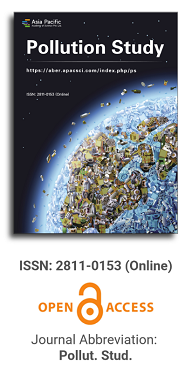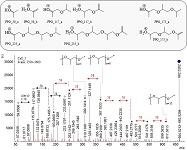
Asia Pacific Academy of Science Pte. Ltd. (APACSCI) specializes in international journal publishing. APACSCI adopts the open access publishing model and provides an important communication bridge for academic groups whose interest fields include engineering, technology, medicine, computer, mathematics, agriculture and forestry, and environment.

The (partial) replacement of synthetic polymers with bioplastics is due to increased production of conventional packaging plastics causing for severe environmental pollution with plastics waste. The bioplastics, however, represent complex mixtures of known and unknown (bio)polymers, fillers, plasticizers, stabilizers, flame retardant, pigments, antioxidants, hydrophobic polymers such as poly(lactic acid), polyethylene, polyesters, glycol, or poly(butylene succinate), and little is known of their chemical safety for both the environment and the human health. Polymerization reactions of bioplastics can produce no intentionally added chemicals to the bulk material, which could be toxic, as well. When polymers are used to food packing, then the latter chemicals could also migrate from the polymer to food. This fact compromises the safety for consumers, as well. The scarce data on chemical safety of bioplastics makes a gap in knowledge of their toxicity to humans and environment. Thus, development of exact analytical protocols for determining chemicals of bioplastics in environmental and food samples as well as packing polymers can only provide warrant for reliable conclusive evidence of their safety for both the human health and the environment. The task is compulsory according to legislation Directives valid to environmental protection, food control, and assessment of the risk to human health. The quantitative and structural determination of analytes is primary research task of analysis of polymers. The methods of mass spectrometry are fruitfully used for these purposes. Methodological development of exact analytical mass spectrometric tools for reliable structural analysis of bioplastics only guarantees their safety, efficacy, and quality to both humans and environment. This study, first, highlights innovative stochastic dynamics equations processing exactly mass spectrometric measurands and, thus, producing exact analyte quantification and 3D molecular and electronic structural analyses. There are determined synthetic polymers such as poly(ethylenglycol), poly(propylene glycol), and polyisoprene as well as biopolymers in bags for foodstuffs made from renewable cellulose and starch, and containing, in total within the 20,416–17,495 chemicals per sample of the composite biopolymers. Advantages of complementary employment in mass spectrometric methods and Fourier transform infrared spectroscopy is highlighted. The study utilizes ultra-high resolution electrospray ionization mass spectrometric and Fourier transform infrared spectroscopic data on biodegradable plastics bags for foodstuffs; high accuracy quantum chemical static methods, molecular dynamics; and chemometrics. There is achieved method performance |r| = 0.99981 determining poly(propylene glycol) in bag for foodstuff containing 20,416 species and using stochastic dynamics mass spectrometric formulas. The results highlight their great capability and applicability to the analytical science as well as relevance to both the fundamental research and to the industry.
Analysis of water pollution in Chinese port regions to inform green port development
Vol 4, Issue 1, 2023
Download PDF
Abstract
Water transport has emerged as one of the most significant modes of transportation globally, owing to its high carrying capacity, low transport costs, and minimal energy consumption. As a critical hub for land-water transfer, ports experience frequent interactions between ships and land, leading to substantial discharges of domestic sewage and oily wastewater, as well as suspended pollutants from construction activities. Consequently, water pollution in port areas has become increasingly severe. To implement sustainable development strategies and promote green port initiatives, it is essential to research and address water pollution in these areas. This paper first summarizes the sources and impacts of the main water pollutants associated with port construction and operations. It then discusses the spatial and temporal distribution patterns of these pollutants. Finally, based on a literature review, the author highlights the current state of water pollution in port areas, advocates for the introduction of ecological engineering solutions for wastewater treatment, compares the differences in water pollution prevention plans between domestic and international ports, and identifies the shortcomings and gaps in existing research and prevention efforts related to water pollution in port areas.
Keywords
References
- Tu Y. Risk Prevention and measures of water pollution at Qiaoxshe Cargo Terminal in Nanchang Port (Chinese). Nanchang: Nanchang University; 2014.
- China Environmental Monitoring Station. Ecological and Environmental Monitoring Bulletin of the Three Gorges Project from 2012 to 2016 (Chinese). Beijing: China Environmental Monitoring Station; 2016.
- Yin J. Study on prevention and Control measures of Ship pollution in Zhangjiagang Port area (Chinese). Xianyang: Northwest A&F University; 2017.
- Chongqing Transportation Commission. Chongqing Traffic Yearbook (Chinese). Chongqing: Communications Press; 2014-2018.
- Yang B. Research on the technical route of “zero Discharge” of Ship pollutants in Chongqing (Chinese). Chongqing: Chongqing Jiaotong University; 2015.
- Xia J. Study on the technology of receiving, transshipment and disposal of Ship pollutants in Chongqing Port (Chinese). Chongqing: Chongqing Jiaotong University; 2017.
- Ju M, Fang J, Shao C, et al. Port Environmental protection and green Port construction (Chinese). Beijing: Chemical Industry Press; 2010. pp. 49-50,58-64.
- Bai J, Yu H. Research on water pollution control strategies of Zhenjiang Port based on green and low-carbon port model (Chinese). China population, resources and environment. 2015; 25(supp.2): 356-359.
- Pan L. Ecological Impact and Countermeasures of Port Construction (Chinese). China Harbour Construction. 2012(2): 65-69.
- Zhou F, Chen M. Comprehensive Influence of Port Construction on Hydrodynamics and Water Environment (Chinese). Water Transportation Engineering. 2020(9): 96-101.
- He G, Shao M, Gao B, et al. Turbidity and its relationship with suspended Solids during Dredging in Dayaowan Sea Channel (Chinese). Marine Environmental Science. 1994(4): 76-82.
- Li J. Study on environmental Impact Assessment technology of Waterway Dredging Project (Chinese). Environmental science and management. 2015; 40(5): 192-194.
- Wang Y, Cheng Y, Xu Z, et al. Effects of suspended sediment on juvenile development and metamorphosis of Eriocheir Sinensis (Eriocheir sinensis) in the Yangtze Estuary (Chinese). Fishery Sciences of China. 1999(SUpp.1): 3-5.
- Xu Z, Shen X, Chen Y. Effects of suspended sediment on the growth of Chaetoceros mousii in the Yangtze Estuary (Chinese). Marine Environmental Science. 2004(4): 28-30.
- Newcombe CP. Effects of Suspended Sediments on aquatic Ecosystems. Nor Am J Fish Manag. 1991(11): 72-82.
- Jia X. Journal of Marine Science and Technology (Chinese). Guangzhou: Guangdong Science and Technology Press; 2000. pp. 242-250.
- Zhu L, Zhu M. Water Pollution caused by Ships in Inland River and its Prevention and Control (Chinese). China Navigation. 2008(3): pp. 289-292,310.
- Dong L. Comprehensive Control strategy of Domestic sewage from Inland River Vessels (Chinese). Journal of Shanghai Maritime University. 2007(3): 10-15.
- Li P, Chen L, Lin R, et al. Countermeasures to Prevent Ship Ballast water Pollution in Xiamen Sea (Chinese). Journal of Dalian Maritime University. 2004(3): 103-105,112.
- Wu B. Study on ship Pollution and Comprehensive Control Measures in the Three Gorges Reservoir Area (Chinese). Resources and Environment in the Yangtze Basin. 2000(4): 487-490.
- Prabowo AR, Bae DM. Environmental risk of maritime territory subjected to accidental phenomena: Correlation of oil spill and ship grounding in the Exxon Valdez’s case. Results in Engineering. 2019; 4: 100035. doi: 10.1016/j.rineng.2019.100035
- Showva NN, Rashid AB. Water pollution and its adverse effect on biodiversity in ship breaking area of Bhatiary,Chattogram. Applied Ecology and Environmental Sciences. 2019; 7(3): 96–100.
- Backer H. Regional work on prevention of pollution from ships in the Baltic Sea—A paradox or a global forerunner? Marine Policy. 2018; 98: 255-263. doi: 10.1016/j.marpol.2018.09.022
- Šateikienė D, Janutėnienė J, Bogdevičius M, et al. Analysis into the selection of a ballast water treatment system. Transport. 2015; 30(2): 145-151. doi: 10.3846/16484142.2015.1045025
- Zhao X, Zhu. Design and Analysis of ecological Drainage System of a coal wharf Project (Chinese). Port engineering technology. 2019; 56(6): 79-82.
- Song G, Pi H. Design of coal sewage collection system in old wharf (Chinese). China’s water transport.
- Central Meteorological Bureau. Precipitation data in China from 1961 to 1970. Beijing: Central Meteorological Bureau; 1976.
- Perricordrk. Direct effects of suspended sediments on aquatic organisms. Cont Sed. 1980(1): 501-535.
- Li L, Yang F, Lu J, et al. Effects of Sediment Suspension on the survival of larvae of Litopenaeus vannamei in Zhanjiang Port (Chinese). Journal of Guangdong ocean university. 2010; 30(3): 91-94.
- Ma M, Gong Q, Liu S, et al. Study on the lethal Effect of suspended solids on Allop prawn (Chinese). Marine Environmental Science. 2004(3): 46-48.
- Weber M, Lott C, Fabricius KE. Sedimentation stress in a scleractinian coral exposed to terrestrial and marine sediments with Contrasting Characteristics of organic matter and Organic matter in Low temperature. Journal of Experimental Marine Biology & Ecology. 2007; 341(1): 151.
- Hewitt JE, Pilditch CA. Environmental history and physiological state influence feeding responses of Atrina zelandica to suspended sediment concentrations. Journal of Experimental Marine Biology and Ecology. 2004; 306(1): 95-112. doi: 10.1016/j.jembe.2004.01.003
- Sun T, Liu H. Study on suspended particulate matter and its ecological effect in Sea area of Port Construction Project (Chinese). Journal of ocean university of China (natural science edition). 2014; 44(8): 89-96.
- Auld AH, Schubel JR. Effects of suspended sediment on fish. Estuarine and Coastal Marine Science. 1978; 6(2): 153-164.
- Greig SM, Sear DA, Carling PA. The impact of fine sediment Effects of incubating salmon progeny on Sediment and Sediment management. Science of the Total Environment. 2005; 344(1-3): 241-258.
- Lake RG, Hinch SG. Acute effects of suspended sediment angularity on juvenile coho salmon (Oncorhynchus kisutch). Canadian Journal of Fisheries and Aquatic Sciences. 1999; 56(5): 862-867. doi: 10.1139/f99-024
- Martha JR, Scruton DA, Clarke KD. Seasonal Effects of Suspended Sediment on the Behavior of Juvenile Atlantic Salmon. Transactions of the American Fisheries Society. 2007; 136(3): 822-828. doi: 10.1577/t06-164.1
- Galbraith RV, MacIsaac EA, Macdonald JS, et al. The effect of suspended sediment on fertilization success in sockeye (Oncorhynchus nerka) and coho (Oncorhynchus kisutch) salmon. Canadian Journal of Fisheries and Aquatic Sciences. 2006; 63(11): 2487-2494. doi: 10.1139/f06-133
- Takashi Y, Tetsuya T, Satoshi A, et al. Effects of suspended Isolation and Isolation of wild and cultured STRAINS of Ayu Pleco Glossus altivelis. Aquaculture. 2011; 314(1): 115-121.
- Zhou Y, Ma S, Qu K, et al. Toxicological Effects of suspended solids on embryos and Larvae of Sole Cynoglossus semilaevis (Chinese). Advances in fishery science. 2009; 30(3): 32-37.
- Lin S, Huang Y, Yang F, et al. Study on the lethal effect of suspended sediment on two Marine animals in Zhanjiang Port area (Chinese). Aquaculture. 2011; 32(4): 40-43.
- Wang T, An X. Investigation and analysis of Ship pollution in the Middle and lower Reaches of the Yangtze River (Chinese). Water Resources Protection. 2004(1): 44-45,56.
- He W, Su J. Current Situation and Countermeasures of Tank washing of Ships carrying Toxic Liquid substances in Bulk in Jiangsu Section of Yangtze Rive (Chinese). China Navigation Society. Proceedings of the Committee of Transportation of Dangerous Goods, China Maritime Society; 2007. pp. 98-103.
- An L, Zhang H, Li K. Analysis of the influence of rainfall weather on atmospheric pollutant concentration (Chinese). Journal of meteorology and environment. 2018; 34(3): 58-70.
- Huang Z, Liu Y, Zhao W, et al. Analysis of temporal and spatial distribution characteristics of water quality in the Source region of the Yangtze River in recent years (Chinese). Journal of Yangtze river scientific research institute. 2016; 33(7): 46-50,67.
- Chen S, He L, Zhang F, et al. Spatial and temporal distribution of water quality in the Yangtze River Basin from 2016 to 2019 (Chinese). Research of environmental science. 2020; 33(5): 1100-1108.
- Qin Y. Spatial and temporal evolution characteristics of major pollutants emissions in the Yangtze River Economic Belt (Chinese). Nanjing: Nanjing University; 2019.
- China Environmental Monitoring Station. National Surface Water Quality Monthly Report 2016-2019 (Chinese). Beijing: China Environmental Monitoring Station; 2019.
- Xiao F. Research on comprehensive treatment technology of wastewater in Zhenjing Oilfield (Chinese). Xi’an: Xi’an Shiyou University; 2012.
- Xu W, Yin C, Xu X, et al. Study on the current situation and Influence of wastewater pollution control in Jiangsu Port and wharf (Chinese). Environment and development. 2018; 30(12): 40-41,43.
- Yang K, Wang T. Prevention and Control measures of Domestic sewage pollution from Ships in the Three Gorges Reservoir Area (Chinese). China water transport (second half). 2020; 20(2): 127-128.
- Li L, Li Y, Gao J. Pollution Prevention and Control experience of American Ships and Ports and Suggestions for China (Chinese). Environment and sustainable development. 2017; 42(5): 111-115.
- Zeng W. Discussion on the Status quo and Suggestions of receiving and Treating domestic Sewage discharge from Ships in Guangzhou Port (Chinese). Pearl River Water Transportation. 2012(12): 73-75.
- Dong K, Wang B. Study on the treatment of petrochemical wastewater by ecological engineering (Chinese). Agricultural Environment Protection. 1999(2): 29-31.
- Qiu Y, Zhang Z, Zhang J, et al. Characteristics of greenhouse gas emission in tail water ecological project of Fengyanlian deep purification wastewater Treatment plant (Chinese). Journal of ecology and rural environment. 2017; 33(4): 364-371.
- Liu J. Research on comprehensive Competitiveness evaluation of Tianjin Port based on low-carbon green concept (Chinese). Dalian: Dalian Maritime University; 2013.
- Chen S. Research on green Port Evaluation of Shanghai Port (Chinese). Nanchang: Nanchang University; 2016.
- Yan P, Liu W, Zhang W. Research on the Responsible innovation Model of Dalian Port. Studies in dialectics of nature (Chinese). 2015; 31(3): 122-126.
- Chen X. Shenzhen Port Construction Planning (Chinese). Port Engineering and Technology. 2002(4): 5-8.
- Li MQ, Tian T, Chen B, et al. Construction of Watershed Non-point Source Water Pollution Emission Inventory Estimation System (Chinese). Chinese Journal of Environmental Management,2019;11(2):94-100. doi: 10.16868/j.cnki.1674-6252.2019.02.094
Supporting Agencies
Copyright (c) 2023 Linlin He, Rui Jia, Yuqi Jiao, Yue Liang

This work is licensed under a Creative Commons Attribution 4.0 International License.

This site is licensed under a Creative Commons Attribution 4.0 International License (CC BY 4.0).
.jpg)
Beijing University of Technology, China



